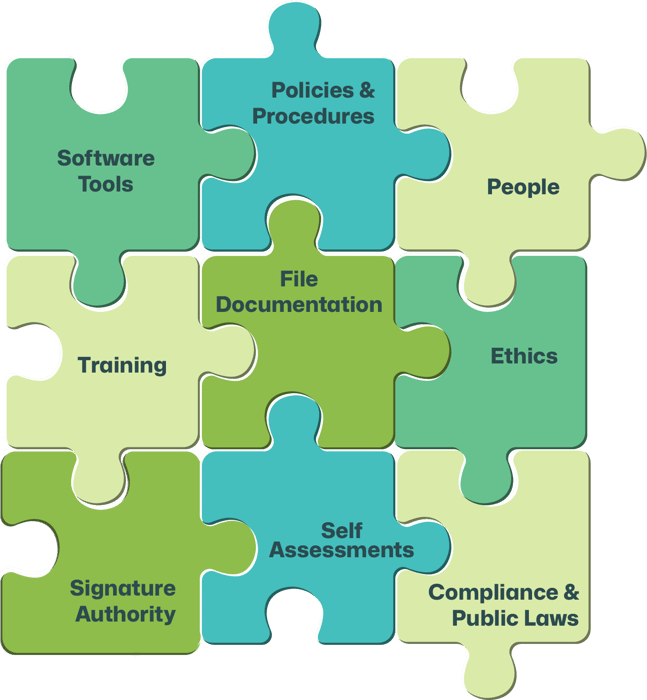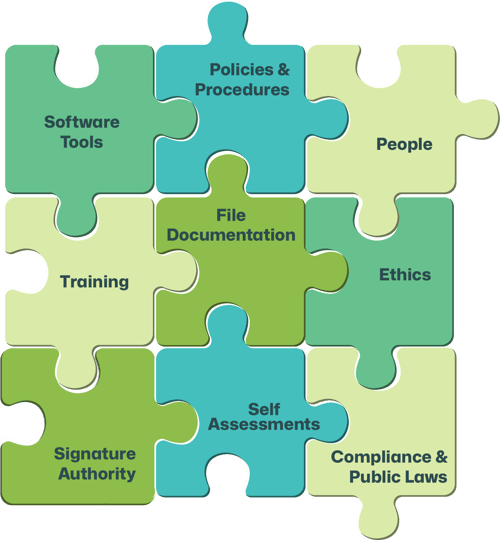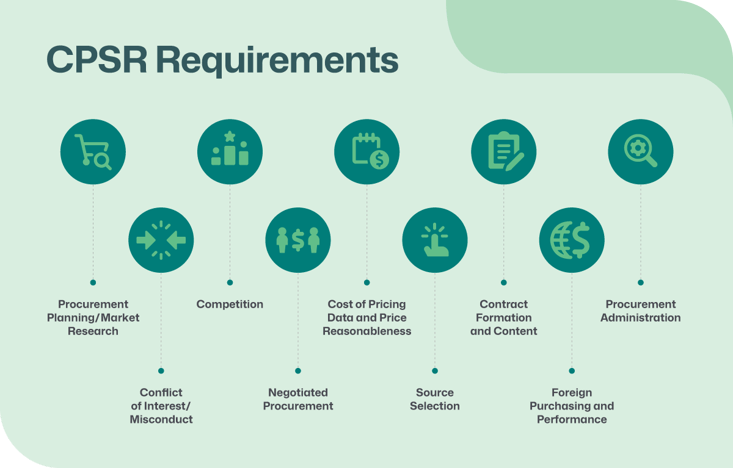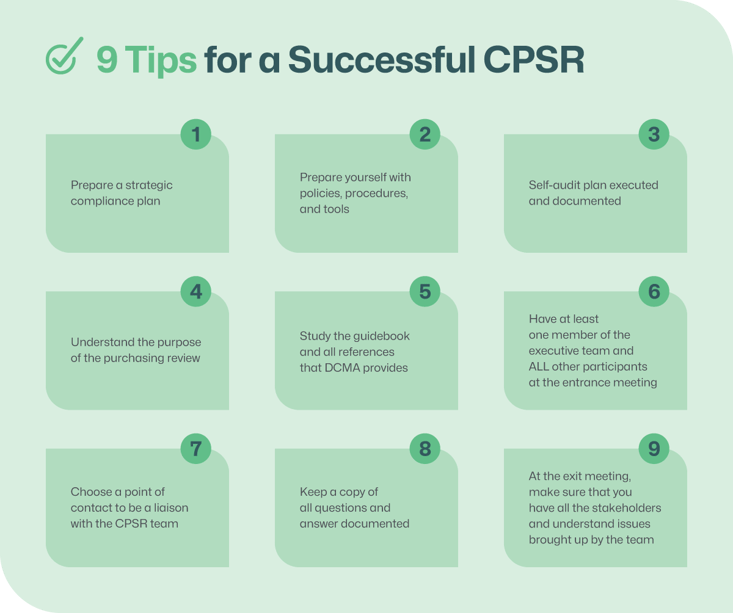What You Should Know About the Contractor Purchasing System Review
Let's review what a CPSR is, and talk about a CPSR compliance checklist to get you on the right path!

Updated April 2024
Navigating the maze of government contracting? Then, you’ll want to be up to speed on the meaning of contractor purchasing system review (CPSR). It's not just another acronym to add to your vocabulary; it's a crucial compliance checkpoint that could make or break your next contract.
Let's break down what a CPSR is and walk you through a CPSR compliance checklist that'll set you on the path to success.
What is a CPSR?
A contractor purchasing system review, or CPSR for short, is performed by the Defense Contract Management Agency (DCMA) to evaluate the efficiency and effectiveness with which a contractor spends government funds and complies with government policy when subcontracting.
Before we learn a little more about the review itself, let’s back up and level-set on what exactly a purchasing system is.
What is an approved purchasing system?
“System” is not interchangeable with “software” or “technology”—it’s not something you purchase off the shelf and install. A contractor’s purchasing system is an amalgamation of people, processes, and tools that must work together to achieve the goal of spending taxpayer dollars wisely.
So, an approved purchasing system has passed a CPSR, meaning it is designed to ensure that purchases are made at fair and reasonable prices and in compliance with the applicable contract terms, regulations, and public laws.

When and why is a CPSR performed?
As stated above, the goal of a CPSR is to ensure that a contractor’s purchasing system works to ensure that the contractor spends government funds in accordance with the Federal Acquisition Regulation (FAR). The review gives the Administrative Contracting Officer (ACO) a basis for granting, withholding, or withdrawing approval of the contractor’s purchasing system.
Contractors cannot initiate a CPSR on their own. Rather, once a contractor’s sales to the government—excluding competitively awarded firm-fixed-price and fixed-price with economic price adjustment contracts and sales of commercial items pursuant to FAR Part 12—are expected to exceed $50 million in the next 12 months, the ACO is required by regulation to conduct a risk assessment.
The ACO will review the contractor’s past performance and the volume, dollar value, and complexity of their purchasing to determine if the risk of ineffective or inefficient purchasing justifies the costs and effort required to perform a CPSR.
Though the ACO is solely responsible for initiating a CPSR, it is possible other government organizations can determine the risk justifies the effort and ask the ACO to schedule a CPSR.
For DOD contractors, a CPSR, meaning one that is contemplated by FAR Subpart 44.3 and DFARS Subpart 244.3, will be conducted by the Defense Contract Management Agency (DCMA) in accordance with its CPSR Guidebook. Civilian agencies might request that DCMA conduct a CPSR on their behalf or contract with an independent audit firm for the review. A few civilian agencies even have in-house teams that can conduct a CPSR.
All CPSRs, except a follow-up review, are predicated on a risk assessment. Take the time to understand what the reviewers will be looking for in your purchasing system. Even if the CPSR is to be conducted by an organization other than DCMA, it is worthwhile to carefully review the DCMA CPSR Policies and Procedure Checklist.
There are 24 DFARS criteria to be addressed and at least 65 items on the DCMA checklist. The DCMA materials are quite comprehensive and a good resource even if another organization will conduct your review.
CPSR References:
- DFARS 252.244-7001, Contractor Purchasing
- System Administration
- DCMA CPSR Policies and Procedures Checklist
- DCMA CPSR Guidebook
Advantages of having an approved purchasing system
You've got your eyes set on that lucrative government contract. But before you dive headfirst into the paperwork, you should know what an approved purchasing system can unlock for your organization.
Not only is it a non-negotiable for many contracts, but having an approved purchasing system acts as a seal of approval that saves you time, minimizes risks, and even gives you an edge over the competition. Maintaining an approved purchasing system (i.e. one that has passed a CPSR) benefits the contractor for many reasons, but let’s touch on two of the most important advantages.
Fulfill a contractual requirement
If you are engaged in contracts that are cost-reimbursable or time and material (T&M) with the Department of Defense, having a strategic plan for compliance is not optional. Clause 252.244.7001 mandates the maintenance of a compliant purchasing system. Should your operations fall under the Cost Accounting Standards, failure to comply allows the government to withhold up to 5% of contract payments. Importantly, these regulations are enforceable even without a formal system review.
Additionally, having an approved purchasing system may not only fulfill solicitation requirements, but also provide a competitive advantage in scenarios such as the recent General Services Administration (GSA) Governmentwide Acquisition Contract (GWAC) solicitations, where bonus evaluation points are at stake.
Minimize the busy work
When a contractor maintains an approved purchasing system, the typical requirements for advance notification and contracting officer consent for subcontracts are generally waived. This streamlined process not only cuts through administrative red tape, but also substantially mitigates associated risks.
Should a contractor fail to secure advance consent for a subcontract—or cannot substantiate that they have done so—CPSR auditors are likely to scrutinize all costs tied to that subcontract, increasing the contractor's exposure to risk.
Risk assessment form
Now that you know why a CPSR is performed, let’s talk about the risk assessment.
The ACO will conduct the risk assessment utilizing the CPSR risk assessment form. Some of the information that will be requested is:
- Company information
- Last CPSR date and recommendations
- Sales data
- Contract type mix
- Sales to the government as a percent of total sales
- Number of POs/subcontracts by dollar values for the most recent year
- Type of business
- Whether you have been suspended from doing business in the past three years.
The ACO will use your completed risk assessment form to determine if a CPSR is warranted and should be scheduled. If you have reached or are about to reach the $50 million threshold, it is time for you to make sure your purchasing system is operating in a manner that can pass a CPSR.
Policies and procedures are a big part of the CPSR
Having and adhering to policies and procedures is the largest part of this review. So, making sure your documentation is in order, up-to-date, followed, and monitored is critical.
Below are some basic, overarching guidelines for your CPSR policies and procedures:
- Establish clear lines of authority and responsibility
- Ensure that all purchases are based on authorized requisitions and include documented support for vendor selected, price paid, and files, which are subject to government review
- Implement internal audits or reviews, training, and policies for the purchasing department to ensure the integrity of the system
- Include a system description detailing policies, procedures, and purchasing practices that comply with the requirements of the FAR and DFARS
- Install a sound organizational and administrative structure to ensure effective and efficient procurement of requirements at the best value from responsible and reliable sources
- Establish a role-based training program for all who participate in the purchasing process
CPSR requirements and DFARS 252.244.7001(a)
DOD’s Business Systems Rule sets forth 24 system criteria that must be present in all contractor purchasing systems for a purchasing system to be “acceptable.”
The criteria are outlined in DFAR 252.244-7001(a). In this blog, we will review these requirements. Below, the DFARS criteria are grouped into summary activities with the applicable criterion.

Procurement Planning/Market Research (2 Criteria)
- Apply a consistent make-or-buy policy that is in the best interest of the government
- Ensure proper type of contract selection and prohibit issuance of cost plus a percentage of cost subcontracts
Conflict of Interest/Misconduct (1 Criterion)
- Enforce adequate policies on conflict of interest, gifts, and gratuities, including the requirements of the Anti-Kickback Act
Competition (2 Criteria)
- Use competitive sourcing to the maximum extent practicable, and ensure debarred or suspended contractors are properly excluded from contract award
- Require management level justification and adequate cost or price analysis, as applicable, for any sole or single source award
Negotiated Procurement (1 Criterion)
- Document negotiations in accordance with the FAR requirements for negotiation Memoranda
Cost of Pricing Data and Price Reasonableness (5 Criteria)
- Evaluate price, quality, delivery, and technical, and financial capabilities of competing vendors to ensure fair and reasonable prices
- Perform cost or price analysis and technical evaluation for each proposal or quote to ensure fair and reasonable subcontract prices
- Document negotiations in accordance with FAR 15.406-3
- Take discounts, including cash discounts, trade discounts, quantity discounts, rebates, freight allowances, and company-wide volume discounts
- Establish and maintain procedures to ensure performance of adequate price or cost analysis on purchasing actions
Source Selection (3 Criteria)
- Use competitive sourcing to the maximum extent practicable, and ensure debarred or suspended contractors are properly excluded from contract award
- Evaluate price, quality, delivery, technical capabilities, and financial capabilities of competing vendors to ensure fair and reasonable prices
- Establish and maintain selection processes to ensure the most responsive and responsible sources and to promote competitive sourcing so that purchases are reasonably priced and from sources that meet quality requirements
Contract Formation and Content (3 Criteria)
- Ensure purchase orders and subcontracts contain all flow-down clauses, including terms and conditions, and any other clauses needed to carry out the requirements of the prime contract
- Notify the government of the award of all subcontracts that contain flow-down clauses that allow for government audit of subcontracts, and ensure the performance of audits of those subcontracts
- Ensure purchase orders and subcontracts contain mandatory and applicable flow-down clauses, as required by the FAR and DFARS
Foreign Purchasing and Performance (3 Criteria)
- Ensure compliance with all relevant domestic preference requirements
- Ensure compliance with export control regulations
- Ensure agreements are not executed with prohibited parties
Procurement Administration (4 Criteria)
- Maintain subcontract surveillance to ensure timely delivery and procedures to notify the government of potential subcontract problems that may impact delivery, quantity, or price
- Document and justify reasons for subcontract changes that affect cost or price
- Ensure that proper types of subcontracts are selected, and that there are controls over subcontracting, including oversight and surveillance of subcontracted effort
- Establish and maintain procedures to timely notify the contracting officer, in writing, of excessive pass-through concerns
Tips for a Successful CPSR
We’re up to speed on what a CPSR looks like. Now, let’s dive deeper into ensuring your CPSR is a successful one.
Navigating a CPSR means starting with a meticulous risk assessment followed by in-depth data questionnaires. It's crucial that you not only ensure the accuracy of your data, but also fully comprehend its implications—this will enable you to quickly respond to reviewers' questions with clarity and care.
If your team lacks prior CPSR experience, consider bringing in a consultant to guide you through the preparation process effectively.

Review the below tips for a successful CPSR:
- Prepare a strategic compliance plan
- Prepare yourself with policies, procedures, and tools
- Self-audit plan executed and documented
- Understand the purpose of the purchasing review
- Study the guidebook and all references that DCMA provides
- Have at least one member of the executive team and ALL other participants at the entrance meeting
- Choose a point of contact to be a liaison with the CPSR team
- Keep a copy of all questions and answer documented
- At the exit meeting, make sure that you have all the stakeholders and understand issues brought up by the team
The CPSR report will state recommendations that the CO/ACO will use to make the final determination of approving or disapproving the purchasing system.
Common Issues
Some common review issues can be easily corrected by taking the time upfront to put together a comprehensive plan. Planning the system is very important, so don’t rush through it. Make sure you are thorough. After the system is planned and documented, it must be executed and maintained to avoid issues.
Below are a few common issues, but this list is by no means exhaustive:
- Policies and procedures don’t address the requirements
- The actual practice doesn’t match the policies and procedures
- Lack of competition – too many sole-source with inadequate justifications
- Inadequate FAR/DFAR flow-downs
- Inadequate price analysis
- Inadequate documentation
Having a Successful CPSR Requires an Integrated ERP Tool
Unanet purchasing software delivers powerful functionality to manage and simplify your buying process, designed to address the specific needs of professional services firms. With Unanet’s centralized system, purchasing integrates directly with timekeeping, expense, financials, and billing, saving time and money, and increasing accuracy.
Our web-based system makes the process easy and visible from purchase requisition (PR), to the issuance of purchase orders (PO), all the way through customer invoices. Through Unanet’s workflow and approval process, all purchasing transactions can be tracked efficiently and integrated into the project forecasts. You can trust the accuracy of the data you are providing to the CPSR team, as well as provide reports with all the needed traceability.
So, what's next?
In today's rapidly evolving world of government contracting, staying compliant and competitive means mastering the intricacies of CPSR. Whether you're a seasoned pro or new to the game, understanding the elements of a robust purchasing system is more than just a compliance checklist—it's a roadmap to success.
If you still have questions, Unanet is here to help. Whether you’re ready to make the transition away from your legacy ERP or want to learn more about Unanet’s ERP and CRM AE solutions, let’s connect!

